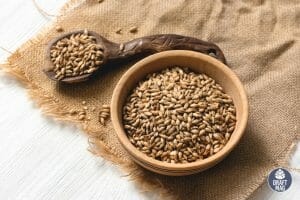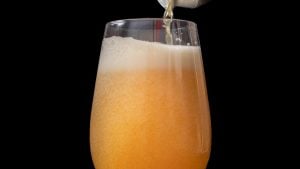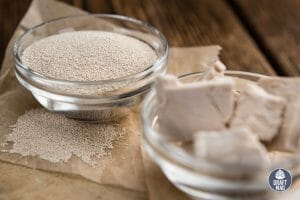Types of Hops: What Kind of Hops Is in Your Favorite Beer?
 Several types of hops are used by different breweries worldwide to produce beers. These beer hops offer distinct flavors to beers, with some offering bittering attributes while others a spicy aromatic flavor. Beer tasting notes result from the chemical composition of the hop strain.
Several types of hops are used by different breweries worldwide to produce beers. These beer hops offer distinct flavors to beers, with some offering bittering attributes while others a spicy aromatic flavor. Beer tasting notes result from the chemical composition of the hop strain.
In this article, we will discuss the different kinds of hops in your favorite beers in detail.
Types of Hops: Classification Based on Their Taste and Smell
There are three major hops classifications based on taste and smell.
These include:
-
Bittering Hops
The addition of the hops during the start of the boiling stage of brewing gives rise to what we know as bitter hops. However, some hops varieties are flavored specially for bittering purposes. Hops with greater than 10 percent alpha acid content tend to fall under this category.
There are varieties of hops in this class.
The most common ones are:
- Chinook hops
- Warrior hops
- Galena hops
Their features are summarized in the table below:
| Chinook hops | Warrior hops | Galena hops | |
| Alpha acid content | 12 – 14 percent | 15 – 17 percent | 13 – 15 percent |
| Total oils volume in 100g (dried) | 1.4 – 2.6 ml | 1.0 – 2.0ml | 1.2 – 2.2 ml |
| Flavor profile | Pine-like, spicy, citrus | Mild | Mild, citrusy, spicy |
| Common Styles | APAs, IPAs, stout barleys | IPAs, American ales | American ales |
| Origin | American | American | American |
-
Aroma Hops
This class of hops appeals more to the smell than the taste. The alpha acid content is usually lower, and they tend to have more essential oils in them, which gives them their aromatic smell. Aroma hops are often added towards the end of boiling.
This table summarizes the features of some of the common aromatic hops:
| Crystal hops | Fuggle hops | Galaxy hops | |
| Alpha acid content | 3 – 5.5 percent | 3 – 6 percent | 13.5 – 14.8 percent |
| Total oils volume in 100g (dried) | 1.0 – 1.4 ml | 0.8 – 1.2 ml | 2.3 – 2.8 ml |
| Flavor profile | Herbal | Floral, herbal | Fruity |
| Common Styles | Lagers, pilsners, Kolsch, | British ales, stout ales | Pale ales, IPAs |
| Origin | Germany | United Kingdom | Australia |
-
Dual-Purpose Hops
This class, as the name indicates, serves both purposes as they contain high amounts of alpha-acids and essential oils, ensuring balance. You get both the bittering and aromatic flavor. These hops are added at any stage during brewing.
The features of the hops types in this class are:
| Citra hops | Simcoe hops | Cascade hops | El Dorado | |
| Alpha acid content | 10.5 – 13.5 percent | 11.5 – 14 percent | 4.5 – 8.5 percent | 13.5 – 15 percent |
| Total oils volume in 100g (dried) | 2.3 – 2.9 ml | 2.0 – 2.6 ml | 0.9 – 1.6vmll | 1.8 – 2.3 ml |
| Flavor profile | citrus, fruity | Piney, citrus | Grapefruit, citrus | Fruity, sweet |
| Common Styles | IPAs, American ales | IPAs, wheat ales | Barley wines, lagers | IPAs, wheat ales |
| Origin | America | America | America | America |
Hops Varieties: The Different Kinds of Hops Based on Geographical Location
Brewers, like chefs, tend to use more than one hop strain in beer production, which makes it difficult to find beers with a specific kind of hop. Different types of hops are grouped based on the location to which they are natively from.
Three major hop strains exist based on location.
-
American Hops
 This hop variety is specifically native to North America. American hops are highly appreciated for the acute flavor they possess. They usually contain large amounts of myrcene’s essential oil — a monoterpene.
This hop variety is specifically native to North America. American hops are highly appreciated for the acute flavor they possess. They usually contain large amounts of myrcene’s essential oil — a monoterpene.
American hops are often described as being citrusy. However, as you venture into this class of hops, you will discover some with a pine-like, woodsy, floral and fruity aroma. The notable American hops tend to fall under the dual-purpose category, some of which will be discussed below.
| Cascade | Centennial | Columbus | Chinook | |
| Alpha acid content | 4.5 – 8.5 percent | 9.5 – 11.5 percent | 14 – 18 percent | 12 – 14 percent |
| Use | Dual-purpose | Dual-purpose | Dual-purpose | Dual-purpose |
| Flavor profile | Grapefruit, citrus, floral | Grapefruit, citrus, floral | Herbaceous, spicy | Pine-like, citrus |
| Common beer types | APAs, lagers, barleys | IPAs, barleys, pale ales | IPAs, barleys, American ales | IPAs, APAs, stout |
-
Cascade
Developed sometime around the 1960s in Oregon State, United States, Cascade is a favorite hop choice for pale lagers. They have a characteristic flavor similar to grapefruit.
Cascade hops are classified under dual-purpose, which is one reason for their wide acceptance for commercial and domestic use. Cultivating them is also easy, making them readily available for use by brewers.
-
Centennial
This hop type is similar to the Cascade in their aromas, no wonder why it is sometimes called the “super cascade.” They were said to have been developed sometime in the 1970s. Like the Cascade, they are a fine blend of aroma and bittering hops, making them ideal as dual-purpose hops.
-
Columbus
This hop is sometimes referred to as Colombia, Tomahawk and Zeus using the abbreviation CTZ. Columbus hops, along with Cascade and Centennial, are regarded as the “Three Cs” hops. They are a group of widely accepted hops used in brewing worldwide.
Unlike the other two of the famous three Cs hops, Columbus is highly rich in alpha acids, making them favorite bittering hops. However, they possess enough essential oils as well, leading to their reputation for being a dual-purpose hop.
-
Chinook
This hop is sometimes regarded as a member of the popular Three Cs American hops. They are another dual-purpose hop class with a high alpha acid percentage with a pine-like aroma. Over the years, Chinook hops have become a widely accepted hop variety, making it easy to find them both in the whole and pellet forms.
-
English Hops
These hops are not so common, occupying less than two percent of the world beer population. Unlike the American hops that are rich in myrcene, this class contains little monoterpene, allowing other essential oils to flourish.
As they are sometimes called, British hops are usually used in the brewing of traditional British ales. The flavor profile of English hops is less intense than those of the Americans, and the flavor profile of the common ones is usually minty, woodsy, lemony, herby, floral, etc. Some notable British hops are discussed as follows.
| Fuggle Hops | Challenger Hops | Pioneer Hops | |
| Alpha acid content | 3 – 6 percent | 6 – 8.5 percent | 8 – 11 percent |
| Use | Aroma hops | Dual-purpose hops | Dual-purpose hops |
| Flavor profile | Minty, cedary, floral | Tea-like, lemon-like, cedary, spicy | Lemon-like, piney, herbal |
| Common beer types | Oatmeal stout, English ales, Strong ales | English ales, Belgian ales, Pale ales | IPAs, English ales |
-
Fuggle
Fuggle hops have been known to the British since the 1870s and have been a very popular variant ever since. Many find the name interesting, but there’s more to it than its interesting name. It comes in nice aromatic flavors with a little alpha acid content, making it an ideal aroma hop.
-
Challenger
This hop is suitable for dual-purpose, serving a fine blend of both bittering and flavored aromatic features thanks to its moderate alpha acid content. It was introduced to breweries sometime around the 1970s and has since been used in many beers in the UK and Europe.
-
Pioneer Hops
This hop is quite well-known for its distinct lemon-like citrus aroma. Pioneer hops are another dual-purpose variety, having a nice blend of alpha-acid content to go with its pleasant flavor.
-
Noble Hops
Of the three major hop strains, the noble hops are the classiest. They are native to Central Europe — specifically Germany and Czech Republic. As indicated by their name, these hops are often treated with reverence as they are the secret to the traditional Central European pilsners and lagers having distinct flavor profiles.
We will discuss the popular ones in this section.
| Hallertau | Saaz | Spalt | Tettnanger | |
| Origin | Germany | Czech Republic | Germany | Germany |
| Alpha acid content | 3 – 5 percent | 2.5 – 5.0 percent | 2.5 – 5.6 percent | 3.5 – 8.0 percent |
| Use | Aroma hops | Aroma hops | Aroma hops | Dual-purpose hops |
| Flavor profile | Spicy, floral | Herbal, spicy, citrus | Spicy, noble, earthy | Herbal, earth spiciness |
| Common beer types | Pilsner,Pale ales, Lagers | Pilsner, Lagers, European blond ales | German ales, Kolsch, Pilsner, Bock | Larger, wheat beers, pilsners, |
-
Hallertau Mittelfrüh Hops
This is probably Europe’s most popular hop strain. It is native to Germany, sometimes referred to as Hallertau or Hallertauer hops. However, they are now being cultivated in some parts of Australia and the United States.
These hops are specially used for their distinct aromatic flavor not known for bittering options in beers, no wonder they have a low alpha acid content. It is a gentle and floral hop variety, having a spicy or somewhat peppery flavor.
-
Saaz
This noble hop is native to a town in the Czech Republic called Saaz. However, it is now being cultivated all over the world. Saaz hops are responsible for the first set of clear beers now known as Pilsners.
Saaz hops are naturally known for their nice aromatic flavors, especially in lager beers native to Europe. In some cases, however, the soft bittering qualities of these beers are now being explored in the production of some Ales.
-
Spalt
Like the Saaz hops, these hops earn their name from their location as they are native to the Spalt region of Germany. Spalt hops are popular for their vast range of aromas – woodsy and peppery.
They are native to Germany and are sometimes referred to as German Spalt. They have a low alpha acid content and are not known to be used as bittering options.
-
Tettnanger
Another hop that derives its name directly from the location it grows from is Germany’s Tettnanger. These hops are known for their versatility and can easily be used in combination with other hop strains, giving brewers a fine blend. They have been cross-bred with the British hops Fuggles and cultivated in various parts of the world.
Tetteng, as they are sometimes called, is known for their distinct aroma, having low alpha acid content making them not ideal for bittering qualities. Tettnanger, Spalt and Saaz all have similar flavors and tastes, and they are often used as substitutes for one another during brewing.
Hop Varieties: The Different Types of Hops Used by Breweries
The different hops strains available give room for brewers to choose the type of beer they wish to produce. The different hops types are native to different regions of the world.
One example is American hops that is native to the American region. We will discuss other hop types in relation to their location with detailed information in subsequent parts of this article.
The amount of alpha acid and essential oils in hops are the major distinguishing features determining the different flavor profiles. In addition, the balance of these two substances distinguishes the taste and smell of hops.
Beer hops with high alpha acid contents tend to give rise to beers with a sharp, bitter taste, while hops with lots of essential oil give off a nice aroma and flavor. However, some strains blend both substances well, making them ideal for bittering and aromatic purposes.
Other Types of Hops Based on Geographical Location
Still on the topic of geographical classification of hops, there are other hops varieties that are native to other regions of the world. Here is a brief overview of some of these hop strains.
– Australian and New Zealand Hops
These hop varieties are usually woodsy or juicy. Some are fruity, which are often sought after in the US. Some common Australian and New Zealand hops are Galaxy, Motueka, Nelson Sauvin, etc.
– European Hops
Besides the English hops and the Noble hops, several parts of Europe have distinct hop variants specific to a particular region. These European hops are Styrian Goldings of Serbian origin, Tomyski of Polish origin, Aramis of French origin, etc.
Conclusion
 Brewers use different hop types with distinctive features in beer production. Hop flavor profiles you get when tasting beers result from the chemical compositions of hop strains. We covered various kinds of hops used in brewing, so let’s summarize them for easier understanding.
Brewers use different hop types with distinctive features in beer production. Hop flavor profiles you get when tasting beers result from the chemical compositions of hop strains. We covered various kinds of hops used in brewing, so let’s summarize them for easier understanding.
- Hops are essential components of beers, used for flavoring and preservative purposes.
- The flavor produced by hops is often a result of the alpha acid content and the essential oils’ volume.
- Brewers often use more than one hop strain for beer production.
- There are two broad categories of beer hops – flavoring properties and geographical location.
- Based on their taste and smell, some of the beer hops include bittering hops, aroma hops and dual-purpose hops.
- Based on their geographical locations, classes of hops include American hops, English hops, Noble hops, Australian hops and European hops.
- Each of these hops classes have various subcategories.
Knowledge of the different beer hops is essential in producing beers with a fine blend of aroma and bittering qualities, and will also help beer lovers choose their favorite hops options from the wide variety available.






